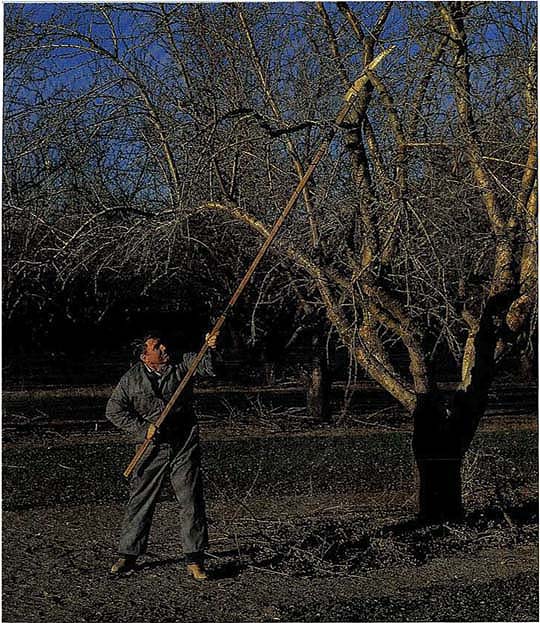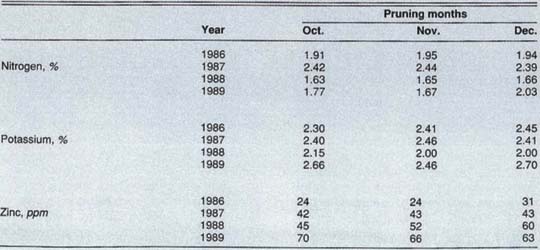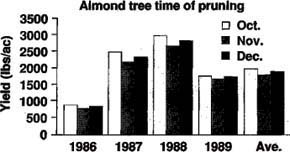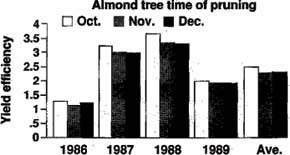All Issues
Fall almond pruning has practical advantages, no adverse effects
Publication Information
California Agriculture 45(3):18-19.
Published May 01, 1991
PDF | Citation | Permissions
Abstract
Labor for pruning during the winter is becoming increasingly scarce. To help retain a permanent labor force, more farmers would like to keep employees working in the fall. This study shows that almond trees can be pruned in the fall without adversely affecting yield, growth or nutrition.
Full text
Almond orchards are usually pruned in the winter after leaf drop. Limb removal at this time improves vigor in the remaining tree without loss of leaf surface and photo synthetic capacity. However, labor for pruning during the winter is becoming increasingly scarce. More growers would like to prune in the fall, either providing year-round employment for their workers or hiring the seasonal labor available after harvest. Weather during this time is often ideal for field work such as pruning. Brush removal is easier with minimal compaction occurring on dry soil, and there are usually more “burn-days” in the fall than in the winter.
However, growers have been concerned that pruning in the fall before leaf drop may devitalize trees, decreasing nutritional status and reducing crop potential the following year. Trees must set as many nuts as possible to maximize production. Previous studies have shown that removal of leaves through July and August pruning decreases vigor.
A trial was initiated in Yolo County on Nonpareil almonds in 1985 to evaluate the effects of early fall pruning compared to pruning when trees are fully dormant.
Methods
Pruning treatments were imposed on an 8-year-old orchard growing on a deep Yolo loam soil with a solid set sprinkler irrigation system. Trees were uniform and had a good production history. The Nonpareil variety was pruned while the alternating rows of Price and Butte served as pollenizers. We arranged three pruning treatments each with 16 single-tree replicates using a randomized complete block design. Each year, pruning occurred on approximately October 15, November 15, and December 15. The same workers pruned the plot throughout the 4 years of the trial with the objective of removing comparable quantities of wood and developing the same type canopy for each treatment.
Pruning consisted of making three to six cuts, 2 to 4 inches in diameter. Fewer cuts were made in trees where the larger limbs were removed. Limbs removed included those interfering with cultural practices; those in dense, crowded areas; those crossing the center of the canopy; and those with older fruiting wood. Trees were pruned every year before the trial was initiated and had strong, healthy growth, which was maintained throughout the 4 years. One-year-old water sprouts were also removed except when needed for limb replacement. Approximately 10% of the fruiting wood was removed each year.
Trees were individually harvested, and the gross weight per tree taken. Kernel percentage was calculated from a sample from each tree to convert gross weight to net weight. Trunk circumference was measured one foot above ground level and converted to cross sectional area. Leaves were sampled and analyzed for nutrients each year by the University Diagnostic Laboratory using standard procedures.
Results
There were no statistically significant differences in yield among any of the treatments although yield was highest in the October-pruned trees and lowest in the November-pruned trees each year (figure 1). Yield among trees within each treatment varied considerably.
Trunk cross-sectional area was largest in the December-pruned treatment and lowest in the November-pruned treatment at the beginning of the experiment. This relationship continued for the 4 years (figure 2). In fact, the increase in trunk cross-sectional area for the 4 years was 218, 222, and 215 cm2. for the October-, November-, and December-pruned trees respectively indicating trunk growth was virtually the same for all three treatments. Since there were no differences in either yield or trunk cross-sectional area, there was also no difference in yield efficiency (figure 3).
Leaf samples taken each summer were analyzed for nitrogen, potassium, and zinc (table 1). Samples were also analyzed for phosphorus, calcium, magnesium, boron, manganese and copper, but little if any difference was found and the results are not shown.
Seasonal differences for nitrogen occurred among years, with 1987 showing the highest reading for all three timings of treatment. The 1986 crop yield was quite low. The grower continued on a normal nitrogen fertilizer program which increased the storage reserves and this, coupled with applications in 1987, most likely provided the higher readings.
All the samples were taken in August for all years except 1989. This late sampling date is probably the reason for the lower-than-expected percentage nitrogen. Even though 1989 was sampled in July, which could have given a higher value, the large crops of 1987 and 1988 appeared to have depleted nitrogen reserves. For the first 3 years, the leaf nitrogen level was very similar among pruning treatments. The higher nitrogen level in 1989 in the December-pruned treatment had not appeared in previous years and may be just sampling error since no other parameter showed any reason for this difference.
The leaf samples also showed differences in the percentage potassium among years, but had no consistent difference between treatments. The lower levels in 1988 indicated a nutritional drain by the large 1987 and 1988 crops. No potassium fertilizer was applied during or preceding this experiment. The 1986 through 1988 samples were taken in August, and a lower potassium level could be expected as compared to the normal July sampling in 1989.
TABLE 1. Nitrogen, potassium and zinc levels in leaf samples from trees pruned during the months indicated
Fig. 1. Comparison of yield when almond trees were pruned each year during either October, November or December for 4 years. No significant difference occurred among treatments for any year.
Fig. 2. Trunk cross-sectional area of trees measured in the fall each year comparing the growth of the trees in response to the three pruning treatments. No significant differences occurred among treatments for any year.
Fig. 3. Yield efficiency computed by dividing yield by the trunk cross-sectional area. Because there was no significant difference in either yield or trunk cross-sectional area, there was no significant difference in yield efficiency among treatments.
Zinc levels increased during the trial even though no additional zinc was applied except for one zinc-based fungicide spray. Levels indicated adequate amounts of zinc present with no consistent differences among pruning treatments.
During the trial, no differences in disease incidence were observed among pruning treatments. Aerial Phytophthora has been a problem in the orchard in the past, but the disease was not found during the 4 years in any of the treatments.
Conclusion
Pruning mature almond trees in October or November before leaf fall had no effect on yield, growth, or nutritional levels when compared to dormant pnming. Nutrient movement from the leaves into the spurs and limbs before normal leaf abscission in the fall has been shown to occur in other studies. The large cuts made on almond trees remove nutrients in leaves when pruned in October or these same nutrients stored in small twigs and spurs when pruned in December. Therefore, removing larger limbs after harvest should have no adverse effect on the almond tree yield or nutrient level the following year.
Pruning in the fall can provide work at a time when few other activities occur in the almond orchard. By scheduling fall pruning, the grower can better utilize a permanent labor force to complete this work before adverse weather occurs. Fall pruning would also take place before dormant sprays are applied, eliminating conflicts between pruning and reentry time intervals. Brush disposal is also generally easier during the fall than during the traditional pruning time in winter.









